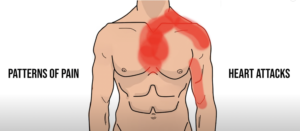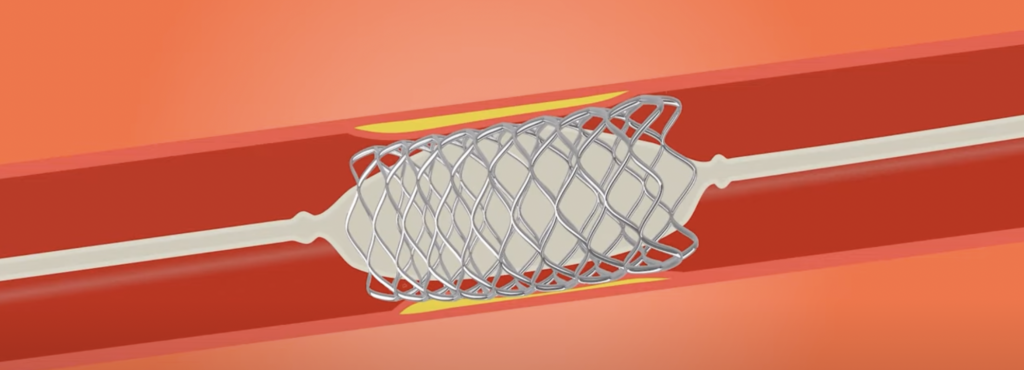Today, we thoroughly covered the topic of heart attacks, including what a heart attack is, its symptoms, treatments, and first-aid measures.
What is Heart Attack?
The heart has 4 chambers that are filled with blood and pump it throughout the entire body. How does it do this?
With the help of its own muscles, which work to push the blood out and keep it circulating.
To keep the heart muscles working, they also need a supply of blood, which is provided by the blood vessels we call coronary arteries.
If, for some reason, there is a blockage or obstruction in these blood vessels that supply the heart, the heart muscles stop receiving proper blood flow. This is what we refer to as a heart attack.
A heart attack means that the heart’s own muscles are not getting the blood supply they need due to a blockage in the pathway.
Let’s explore how the structure of the heart functions. The heart has 4 chambers.

- Right Atrium
- Right Ventricle
- Left Ventricle
- Left Atrium
HEART GETS BLOOD TO WORK THROUGH CORONARY ARTERIES. LACK OF BLOOD SUPPLY TO THE HEART MUSCLES IS CALLED HEART ATTACK
Who’s At Higher Risk?
Who are the people who are more at risk of heart attack?
Some people are at higher risk of having a heart attack. For example, smokers, those with a family history of heart attacks, individuals with diabetes, high blood pressure, elevated cholesterol levels, poor lipid profiles, or those who are overweight are all at increased risk.
Apart from this, other people are also at risk, but the risk is less. All these populations are at high risk.
PEOPLE AT HIGH RISK: SMOKERS, GENETICS, DIABETES, HYPERTENSIVE, BAD LIPID PROFILE, OBESITY
What are the Signs and Symptoms of Heart Attack?
How do you know if someone is having a heart attack?
1. Patterns of Pain
During a heart attack, if the blood supply to the heart muscles is interrupted, it can cause pain.



This pain typically occurs in the center of the chest, on the left side, and may radiate to the upper jaw or extend to the left arm. However, it’s not always classic; sometimes the pain is confined to the center of the chest.
2. What Happens Besides Pain?
Because if your heart muscles are not getting blood, the pumping of the heart becomes weak.
Due to the weakening of the heart’s pumping, blood supply to the brain stops, we feel dizzy, we start vomiting, there is a feeling of thick cloth in the chest and due to lack of pumping, all the blood gets stuck in our lungs and we even stop breathing.
During a heart attack, if the blood supply to the heart muscles is disrupted, it can result in pain. This pain usually manifests in the center of the chest, on the left side, and may radiate to the upper jaw or the left arm.
However, this isn’t always the case; sometimes the pain is limited to the center of the chest.
Here are the symptoms of heart attack. Pain in the chest, heaviness, nausea, vomiting, dizziness, and fainting are all symptoms that indicate a heart attack.
This is especially true if you are at high risk or if someone in your family has had a heart attack.
Sometimes, particularly in diabetic patients, a heart attack can occur without pain, showing only the other symptoms. This is referred to as a silent MI.
SIGNS OF HEART ATTACK: CHEST PAIN, DIZZINESS, VOMITING, HEAVY CHEST, BREATHING DIFFICULTY
SILENT HEART ATTACK: SOME PEOPLE MIGHT FEEL NO PAIN DURING HEART ATTACKS, COMMONLY SEEN IN DIABETICS
What is the Treatment of Heart Attack?
Since the blood vessels supplying the heart muscles were blocked during a heart attack, the treatment involves opening up these blockages.
Mainly heart attack is of 2 types.
TYPE 1:
In this condition, the blood vessel (blood vessel) becomes 100% blocked.
What happens here is that the heart muscles don’t receive any blood at all, and the muscles in that area begin to die. This is a very serious condition, known in medical terms as STEMI.
STEMI HEART ATTACK: IS A TYPE OF HEART ATTACK THAT IS MORE SERIOUS AND HAS A GREATER RISK OF SERIOUS COMPLICATIONS AND DEATH IMMEDIATE CARE IS REQUIRED IN ANY CASE OF HEART ATTACK
It is crucial to open the blockage as quickly as possible because if we don’t open it immediately, the entire area of the heart muscles supplied by that blood vessel will start to die, leading to many complications later on.
In some cases, it can even result in death, which is why it is extremely important to open the blockage right away.
Ideally, the blockage should be opened within 1 hour, but the sooner you reach the hospital, the quicker the blockage can be cleared.
WITHIN ONE HOUR: THESE BLOCKAGES MUST BE RESOLVED WITHIN 1 HOUR, IN SUCH SIGNS RUSH TO THE HOSPITALS IMMEDIATELY
There are 3 methods to remove the blockage.
1. Thrombolysis Therapy:
The blockage is opened by injecting medicine into the blood, which we call thrombolytic therapy.
THROMBOLYTIC THERAPY: THE USE OF MEDICATIONS TO DESTROY BLOOD CLOTS OR PREVENT NEW BLOOD CLOTS FROM FORMING
2. Balloon Angioplasty
Angioplasty removes or opens the blockage with the help of a balloon.
BALLOON ANGIOPLASTY: CATHETER WITH BALLOON WIDENS BLOCKAGE IN ARTERY, BOOSTING HEART FLOW
3. Angioplasty and Stenting
A metal stent is inserted in the blockage area to prevent rupture and free flow of blood.
ANGIOPLASTY AND STENTING: TINY MESH TUBE (STENT) PLACES IN ARTERY TO KEEP IT OPEN, IMPROVES HEART BLOOD FLOW

How do we detect this complete blockage?
Generally, we can identify this blockage through ECG changes.
So, in the case of complete blockage, opening it immediately is a top priority and absolutely necessary.
TYPE 2:
In cases where the blockage is partial, meaning the blood vessels are partially or mostly blocked, the patient experiences pain.
However, as long as some blood supply is still reaching the heart, the heart muscles remain alive, and the complications are less severe. This can be detected through ECG or with the help of blood tests such as troponin.
PARTIAL OCCLUSION: PARTIAL CORONARY ARTERY BLOCKAGE MAY CAUSE CHEST PAIN, SHORTNESS OF BREATH, FATIGUE, DURING EXERTION
CORONAVIRUS OCCLUSION CAN VE IDENTIFIED THROUGH ECG AMD TRPPONIN TEST
What happens if the blockage in your heart isn’t opened in time?
If the blockage isn’t addressed, the muscles in that area will die. This can lead to heart pump failure, abnormal heart rhythms, valve defects, or even rupture in the affected area.
In cases where a large area or major blood vessels are involved, it can be fatal. This is an emergency situation requiring immediate hospitalization.
IT’S AN EMERGENCY: IMMEDIATE TREATMENT IS REQUIRED
First Aid- Recognizing Heart Attack
Let’s understand what to do if someone in front of you is having a heart attack.
First and foremost, it’s important to recognize that a heart attack is occurring. How do you recognize it?
By being aware of all the symptoms we’ve studied earlier. Chest pain, heaviness, fainting, difficulty breathing, vomiting, dizziness—these are all symptoms.
If the person is also at high risk, meaning they have diabetes, high blood pressure, high cholesterol, obesity, are a smoker, or have a family history, and these symptoms are present, then there are high chances that they are having a heart attack. So, the first and most important step is to recognize these signs.
SIGNS OF HEART ATTACK: CHEST PAIN, DIZZINESS, VOMITING, HEAVY CHEST, BREATHING DIFFICULTY
PEOPLE AT HIGH RISK: SMOKERS, GENETICS, DIABETES, HYPERTENSIVE, BAD LIPID PROFILE, OBESITY
First Aid- Call For Help
When a heart attack occurs, it’s crucial to open the blocked vessels immediately, otherwise the affected area of the heart can become damaged, leading to tissue death. It’s vital to reach the hospital as quickly as possible.
It is also important to know which hospital to go to?
Because angioplasty services are provided by cardiologists only. You should go to a super specialty hospital where there is a cardiologist.
RUSH TO THE HOSPITAL: EARLY INTERVENTION SIGNIFICANTLY IMPROVES SURVIVAL RATES. THE SOONER THE BLOOD FLOW IS RESTORESD, THE BETTER THE CHANCES OF SURVIVAL AND RECOVERY. TIME IS MUSCLE
But if there is no super specialty hospital near you, you can go to any other hospital as the services to dissolve the clot with medicine are also available in other hospitals.
Next, it is important that you should be brought to the hospital yourself or should you call an ambulance?
If you can call an ambulance, it is always preferred. Because in case of a heart attack, sometimes the rhythm gets disturbed while reaching the hospital.
SUPER SPECIALITY HOSPITAL: PREFER HOSPITALS WITH CARDIOLOGY DEPARTMENT ELSE REACH THE BEST NEAREST HOSPITAL
This means that abnormal rhythm starts developing and its treatment is done in the ambulance.
Sometimes the patient becomes unconscious, BP drops, you will get its treatment in the ambulance.
Sometimes the patient suffers a cardiac arrest, which means that the heart stops working completely, its treatment is also possible in the ambulance.
If there is a need for oxygen, if there is a lot of pain then you initially get the painkiller in the ambulance. That is why if you have arranged an ambulance then you should go by ambulance only.
PREFER AMBULANCE: AMBULANCES ARE EQUIPPED TO PRIVIDE ADVANCED LIFE SUPPORT TO PATIENTS IN NEED